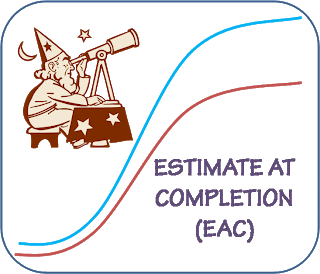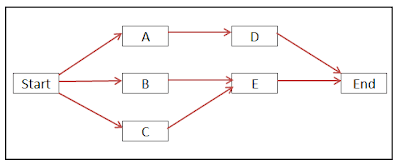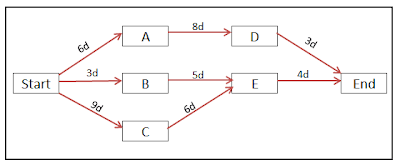I have written a short list of 10 mock PMP exam questions. In this article, I have given the correct answer choices to those PMP exam questions. Relevant explanations are also given for you to understand why the answer choice is the best choice available.
If you still have any doubts, you can drop your comments in the section below. If you feel the correct answer choice should be something else, please provide your line of thought and we can discuss.
Explanation: The Project Manager is in the Plan Schedule Management process; this is the process of establishing the policies, procedures and documentation for planning, developing, managing, executing and controlling the project schedule. Expert judgment, Meetings and Analytical Techniques are all the Tools & Techniques of Plan Schedule Management.
The only exception is Decomposition. Decomposition is used as a tool in "Create WBS" and "Define Activities".
Explanation: Historical information, Templates and Change Control Procedures are all examples of Organizational Process Assets. Organizational Structure is not an Organizational Process Asset; it is part of the Enterprise Environmental Factors.
Explanation: Define Activities is the process of identifying and documenting the specific actions to be performed to produce the project deliverables.The output of define activities is a list of activities.
So, the immediate next action would be to identify the relationships among the activities. This process of identifying and documenting the relationships among project activities is called "Sequence Activities".
So, the correct answer is "Sequence Activities".
Explanation: The relationship is: Finish laying of road =>Wait 28 days => Start using the road.
Here, 28 days is the lag for which the next activity should wait. So, the relationship is Laying of road => FS+28d => Start of use of the road.
The correct answer choice is Option C.
Explanation: Resource leveling is a technique in which start and finish dates are adjusted based on resource constraints with the goal of balancing demand for resources with the available supply.
Explanation: A project is a temporary endeavor; but, it does not necessarily mean the duraion of the project is short. Please note that repetitive elements may be present in some project deliverables and activities; but, this repetition does not change the fundamental, unique characteristics of the project work. You also should understand a project can involve a single or mulitple individuals, a single organization or multiple organizations.
Explanation: The project charter is created long before you start identifying work packages and activities. Project charter typically contains only high level information while work packages are created with detailed information.
Explanation: Delphi technique is an information gathering technique. The remaining three are quantitative risk analysis techniques
Explanation: FV = PV(1+i)^n. In this problem, Future Value FV = $48,400, rate of return I = 10% and number of years n =2. Substituting these values in the formula, you will get Present Value PV = $40,000
Explanation: Project B was preferred over project A. So, the opportunity cost would be the NPV of project A, which was not chosen.
If you still have any doubts, you can drop your comments in the section below. If you feel the correct answer choice should be something else, please provide your line of thought and we can discuss.
Answers to Mock PMP Exam Questions
Mock PMP Exam Question No: 1
Correct Answer: CExplanation: The Project Manager is in the Plan Schedule Management process; this is the process of establishing the policies, procedures and documentation for planning, developing, managing, executing and controlling the project schedule. Expert judgment, Meetings and Analytical Techniques are all the Tools & Techniques of Plan Schedule Management.
The only exception is Decomposition. Decomposition is used as a tool in "Create WBS" and "Define Activities".
Mock PMP Exam Question No: 2
Correct Answer: BExplanation: Historical information, Templates and Change Control Procedures are all examples of Organizational Process Assets. Organizational Structure is not an Organizational Process Asset; it is part of the Enterprise Environmental Factors.
Mock PMP Exam Question No: 3
Correct Answer: CExplanation: Define Activities is the process of identifying and documenting the specific actions to be performed to produce the project deliverables.The output of define activities is a list of activities.
So, the immediate next action would be to identify the relationships among the activities. This process of identifying and documenting the relationships among project activities is called "Sequence Activities".
So, the correct answer is "Sequence Activities".
Mock PMP Exam Question No: 4
Correct Answer: CExplanation: The relationship is: Finish laying of road =>Wait 28 days => Start using the road.
Here, 28 days is the lag for which the next activity should wait. So, the relationship is Laying of road => FS+28d => Start of use of the road.
The correct answer choice is Option C.
Mock PMP Exam Question No: 5
Correct Answer: BExplanation: Resource leveling is a technique in which start and finish dates are adjusted based on resource constraints with the goal of balancing demand for resources with the available supply.
Mock PMP Exam Question No: 6
Correct Answer: BExplanation: A project is a temporary endeavor; but, it does not necessarily mean the duraion of the project is short. Please note that repetitive elements may be present in some project deliverables and activities; but, this repetition does not change the fundamental, unique characteristics of the project work. You also should understand a project can involve a single or mulitple individuals, a single organization or multiple organizations.
Mock PMP Exam Question No: 7
Correct Answer: CExplanation: The project charter is created long before you start identifying work packages and activities. Project charter typically contains only high level information while work packages are created with detailed information.
Mock PMP Exam Question No: 8
Correct Answer: DExplanation: Delphi technique is an information gathering technique. The remaining three are quantitative risk analysis techniques
Mock PMP Exam Question No: 9
Correct Answer: BExplanation: FV = PV(1+i)^n. In this problem, Future Value FV = $48,400, rate of return I = 10% and number of years n =2. Substituting these values in the formula, you will get Present Value PV = $40,000
Mock PMP Exam Question No: 10
Correct Answer: CExplanation: Project B was preferred over project A. So, the opportunity cost would be the NPV of project A, which was not chosen.









